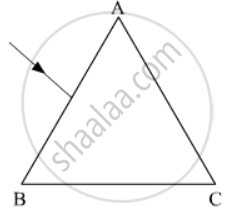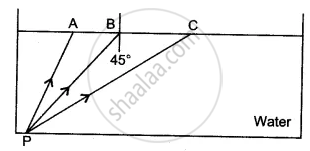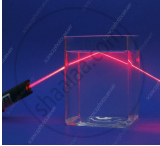Advertisements
Advertisements
प्रश्न
A ray of light is incident on a glass surface at an angle of 50° with the corresponding angle of refraction 30°. Find the value of the R.I. of glass.
उत्तर
R.I. = `sin"i"/sin"r"`
aμg = `sin"i"/sin"r"=(sin50°)/(sin30°)` ..........(∠i = 50° and ∠r = 30°)
= `0.7660/0.5000`
aμg = 0.1532.
APPEARS IN
संबंधित प्रश्न
The figure shows a ray of light falling normally on the face AB of an equilateral glass prism having refractive index`3/2`, placed in water of refractive index `4/3`.Will this ray suffer total internal reflection on striking the face AC? Justify your answer.

State the relation between the critical angle and the absolute refractive index of a medium.
What is total internal reflection?
Prove the statement.
A rainbow is the combined effect of the refraction, dispersion, and total internal reflection of light.
Make the correct choices for each of the following :
Total Internal reflection takes place when
(where ∠i = angle of incidence, ∠r = angle of refraction, ∠C = critical angle)
The diagram shows a point source P inside a water container. Three rays A, B, and C starting from P are shown up to the water surface. Show in the diagram the path of these rays after striking the water surface. The critical angle for the water-air pair is 48°.

Answer the following question.
Explain ‘mirage’ as an illustration of refraction.
Observe the given figure and write appropriate phenomenon of light in the box.

The resultant `vec"R"` of `vec"P"` and `vec"Q"` is perpendicular to `vec"P"`. Also `|vec"P"|=|vec"R"|`. The angle between `vec"P"` and `vec"Q"` is ______.
[tan 45° = 1]
What are the examples of total internal reflection in nature?
